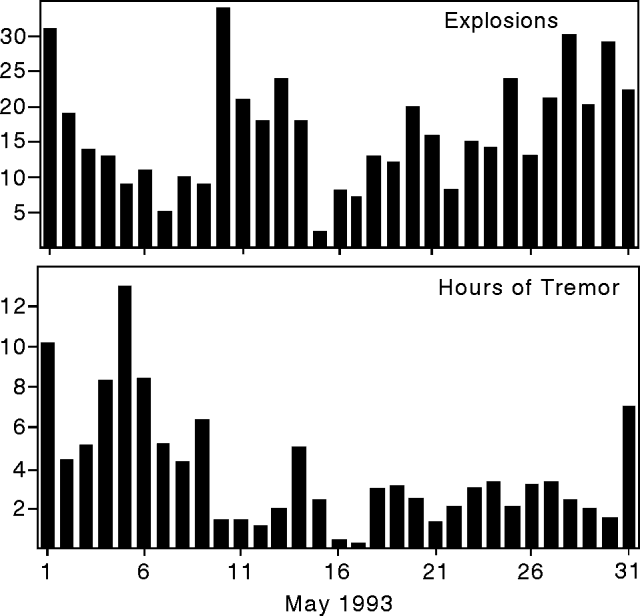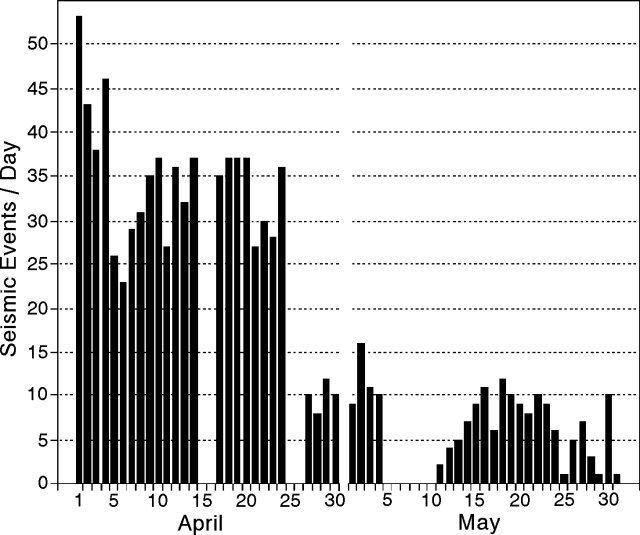Report on Arenal (Costa Rica) — May 1993
Bulletin of the Global Volcanism Network, vol. 18, no. 5 (May 1993)
Managing Editor: Edward Venzke.
Arenal (Costa Rica) More lava; ash explosions decrease
Please cite this report as:
Global Volcanism Program, 1993. Report on Arenal (Costa Rica) (Venzke, E., ed.). Bulletin of the Global Volcanism Network, 18:5. Smithsonian Institution. https://doi.org/10.5479/si.GVP.BGVN199305-345033
Arenal
Costa Rica
10.463°N, 84.703°W; summit elev. 1670 m
All times are local (unless otherwise noted)
Activity continued at Crater C in April and May with gas emission and lava flows. Several areas near the summit and within the crater contained active fumaroles. Fumarolic activity was also present in Crater D. Explosive activity from Crater C was continuing, but has declined since early in the year. An average of 7.2 g/m2/day of ash was collected by ICE geologists between 30 March and 5 May at a point 1.8 km W of the active crater. During January and February of this year, an average of 18.5 g/m2/day was collected.
Sporadic ash eruptions reached 600 m above the crater rim. Ballistic bombs and blocks fell to 1,100 m elevation. The SW-flank lava flow that started from Crater C in March remained active in May, with the W lobe stopping at 1,000 m, 50 m below the April terminus. The W lobe of the SW-flank lava flow that began in mid-April stopped at 1,200 m elevation, while the SW lobe reached 1,250 m. The flow that was descending SSW in March and April, reaching 1,400 m elevation, is no longer active. Small avalanches or pyroclastic flows are occasionally generated from the lava flow fronts. A new lava flow began traveling W in early May and reached 1,400 m. One lobe, to the WNW, continued to almost 1,200 m elevation and generated frequent block collapses, which have filled the valley between it and the October 1991 to March 1992 lava flows. Three Merapi-type pyroclastic flows were observed moving WSW at 1235 on 12 May. Ash clouds from these pyroclastic flows reached 300-500 m height.
Deformation measured at dry-tilt stations between 2 March and 15 April was less than the survey error limits. Slight inflation was detected at the NW dry-tilt stations during this period, and the radial distance to the crater increased 23 ppm SW and 12 ppm S. The seismic station 2.7 km NE of the active crater (VACR, operated by OVSICORI) recorded 496 explosions, most associated with gas and vapor emission (figure 57, top). This is a significant decrease from April, when 1,314 explosions were recorded . . . . The highest daily number of seismically detected explosions (34) occurred on 10 May. A similar decrease in seismicity since April was evident at a seismic station 3.5 km E of the active crater (Fortuna, operated by ICE). This station recorded an average of 30 volcanic seismic events/day in April, decreasing to an average of 10 events/day in May (figure 58). Several small tectonic events, an average of 3/day, were also detected, with epicenters <=25 km from the volcano. Middle- and low-frequency tremor was recorded at the VACR station for 123 hours in May (figure 57, bottom); frequencies were <3 Hz.
 |
Figure 57. Daily totals of seismically detected explosions (top) and hours of tremor (bottom) recorded 2.7 km NE of the active crater at Arenal, May 1993. Courtesy of OVSICORI. |
 |
Figure 58. Daily totals of volcanic seismic events recorded 3.5 km E of the active crater at Arenal, April-May 1993. Gaps in data are a result of equipment failure. Courtesy of Gerardo Soto, ICE. |
Geological Summary. Conical Volcán Arenal is the youngest stratovolcano in Costa Rica and one of its most active. The 1670-m-high andesitic volcano towers above the eastern shores of Lake Arenal, which has been enlarged by a hydroelectric project. Arenal lies along a volcanic chain that has migrated to the NW from the late-Pleistocene Los Perdidos lava domes through the Pleistocene-to-Holocene Chato volcano, which contains a 500-m-wide, lake-filled summit crater. The earliest known eruptions of Arenal took place about 7000 years ago, and it was active concurrently with Cerro Chato until the activity of Chato ended about 3500 years ago. Growth of Arenal has been characterized by periodic major explosive eruptions at several-hundred-year intervals and periods of lava effusion that armor the cone. An eruptive period that began with a major explosive eruption in 1968 ended in December 2010; continuous explosive activity accompanied by slow lava effusion and the occasional emission of pyroclastic flows characterized the eruption from vents at the summit and on the upper western flank.
Information Contacts: E. Fernández, J. Barquero, F. De Obaldía, T. Marino, R. Van Der Laat, V. Barboza, and R. Saenz, OVSICORI; G. Soto, ICE.

